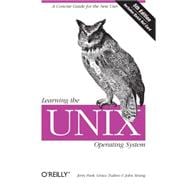
Note: Supplemental materials are not guaranteed with Rental or Used book purchases.
Purchase Benefits
What is included with this book?
is a long time user of the Unix operating system. He has acted as a Unix consultant, courseware developer, and instructor. He is one of the originating authors of Unix Power Tools and the author of Learning the Unix Operating System by O'Reilly.
John Strang now finds himself "a consumer--rather than a producer of Nutshells." He is currently a diagnostic radiologist (MD) at Stanford University. He is married to a pediatrician, Susie, and they have two children, Katie and Alex. John enjoys hiking, bicycling, and dabbling in other sciences. He plans to use his experience as an author at ORA to write his own book on radiology.
| Preface | vii | ||||
|
1 | (16) | |||
|
1 | (10) | |||
|
11 | (3) | |||
|
14 | (1) | |||
|
14 | (3) | |||
|
17 | (25) | |||
|
18 | (1) | |||
|
19 | (2) | |||
|
21 | (5) | |||
|
26 | (3) | |||
|
29 | (6) | |||
|
35 | (2) | |||
|
37 | (2) | |||
|
39 | (1) | |||
|
40 | (2) | |||
|
42 | (24) | |||
|
42 | (12) | |||
|
54 | (2) | |||
|
56 | (5) | |||
|
61 | (1) | |||
|
62 | (1) | |||
|
62 | (1) | |||
|
63 | (3) | |||
|
66 | (21) | |||
|
66 | (1) | |||
|
67 | (2) | |||
|
69 | (5) | |||
|
74 | (7) | |||
|
81 | (6) | |||
|
87 | (10) | |||
|
87 | (5) | |||
|
92 | (5) | |||
|
97 | (33) | |||
|
97 | (3) | |||
|
100 | (1) | |||
|
101 | (3) | |||
|
104 | (4) | |||
|
108 | (10) | |||
|
118 | (5) | |||
|
123 | (7) | |||
|
130 | (6) | |||
|
131 | (1) | |||
|
132 | (2) | |||
|
134 | (2) | |||
|
136 | (7) | |||
|
136 | (3) | |||
|
139 | (1) | |||
|
139 | (1) | |||
|
140 | (3) | |||
| Glossary | 143 | (6) | |||
| Index | 149 |
The New copy of this book will include any supplemental materials advertised. Please check the title of the book to determine if it should include any access cards, study guides, lab manuals, CDs, etc.
The Used, Rental and eBook copies of this book are not guaranteed to include any supplemental materials. Typically, only the book itself is included. This is true even if the title states it includes any access cards, study guides, lab manuals, CDs, etc.